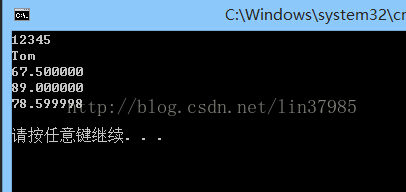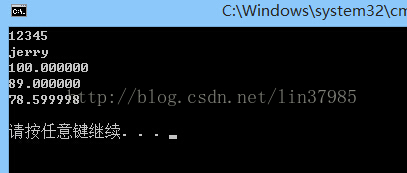首先结构体做函数参数有三种传递方式:
一是传递结构体变量,这是值传递,二是传递结构体指针,这是地址传递,三是传递结构体成员,当然这也分为值传递和地址传递。
以传引用调用方式传递结构比用传值方式传递结构效率高。以传值方式传递结构需要对整个结构做一份拷贝。
下面看一个列子,student结构体中包含该学生的各种信息,我们在change函数中对其进行部分修改,再在主函数中输出其结果
1.下面传递结构体变量
#include
#include
#define format "%d\n%s\n%f\n%f\n%f\n"
struct student
{
int num;
char name[20];
float score[3];
};
void change( struct student stu );
int main()
{
struct student stu;
stu.num = 12345;
strcpy(stu.name, "Tom");
stu.score[0] = 67.5;
stu.score[1] = 89;
stu.score[2] = 78.6;
change(stu);
printf(format, stu.num, stu.name, stu.score[0], stu.score[1],stu.score[2]);
printf("\n");
return 0;
}
void change(struct student stu)
{
stu.score[0] = 100;
strcpy(stu.name, "jerry");
}

可以看到最终输出的值并未改变。。。
2.地址传递
#include
#define format "%d\n%s\n%f\n%f\n%f\n"
struct student
{
int num;
char name[20];
float score[3];
};
void change( struct student* stu );
int main()
{
struct student stu;
stu.num = 12345;
strcpy(stu.name, "Tom");
stu.score[0] = 67.5;
stu.score[1] = 89;
stu.score[2] = 78.6;
change(&stu);
printf(format, stu.num, stu.name, stu.score[0], stu.score[1],stu.score[2]);
printf("\n");
return 0;
}
void change(struct student* p)
{
p->score[0] = 100;
strcpy(p->name, "jerry");
}

可以看到,通过地址传递修改了结构体内的数据
用&stu做实参,&stu是结构体变量stu的地址。在调用函数时将该地址传送给形参p(p是指针变量)。这样p就指向stu。
在change函数中改变结构体内成员的值,在主函数中就输出了改变后的值
3.结构体成员的地址传递和值传递
这个类似于单一变量的传递,这里也没必要说了,当然是地址传递才能修改。
把一个完整的结构体变量作为参数传递,要将全部成员值一个一个传递,费时间又费空间,开销大。如果结构体类型中的成员很多,或有一些成员是数组,则程序运行效率会大大降低。在这种情况下,用指针做函数参数比较好,能提高运行效率。





















 3338
3338











 被折叠的 条评论
为什么被折叠?
被折叠的 条评论
为什么被折叠?








